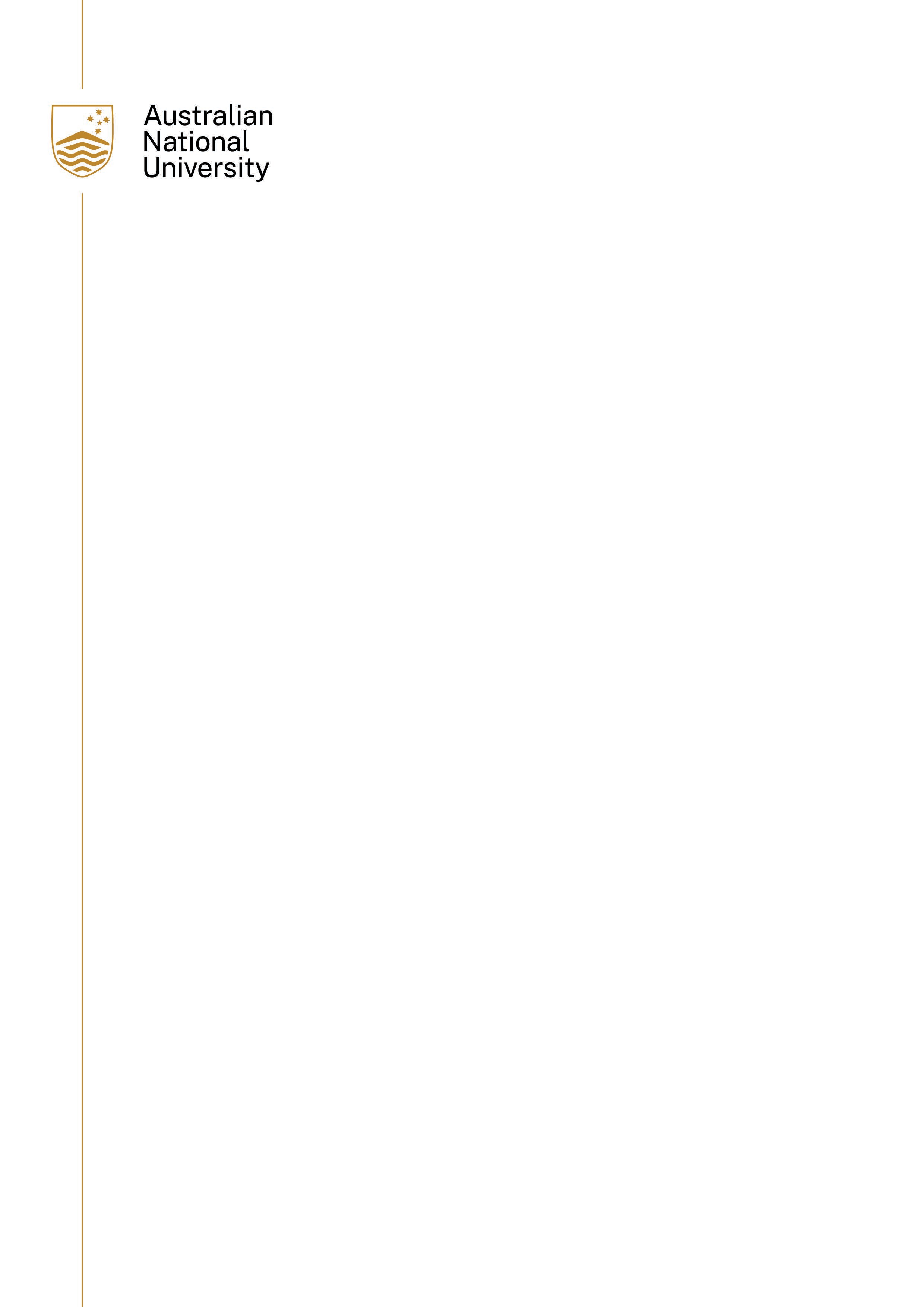
Kathryn Dan
Associate Director, Records
and Archives
Scholarly Information
Services Division
xxx@xxx.xxx.xx
29 January 2025
Sam Smith
Via Email
: xxxxxxxxxxxxxxxxxxxxxxxxxx@xxxxxxxxxxx.xxx.xx
Freedom of Information Request 202400158 – Notification of decision
Dear Sam Smith,
On 2 December 2024, the Australian National University received your request seeking
access to documents under the
Freedom of Information Act 1982 (the Act)
.
On 18 December 2024, the University sought an extension of time to process your
request under s15AA of the Act. You agreed to this extension via return email on 19
December 2024, giving a new decision date of 31 January 2025.
1.
Scope of Request
I have taken your request to be as follows:
Copies of engagement letters and terms of reference for the investigation into
WHS concerns of the National Computational Infrastructure (NCI) conducted by
Ashurst.
Date range for the documents being requested is February 2024 to June 2024.
The purpose of this letter is to provide you with a final decision on your request for
access under the Act.
2.
Authority to Make Decision
I am an officer authorised under section 23 of the Act to make decisions in respect of
requests to access documents or to amend or annotate records.
The Australian National University
Canberra 2600, ACT Australia
TEQSA Provider ID: PRV12002 (Australian University)
CRICOS Provider Code: 00120C

3.
Relevant Material
In reaching my decision I referred to the following:
The terms of your request
Documents relevant to your request
Advice from University staff with responsibility for matters relating to the
documents to which you sought access
The FOI Act 1982 (Cth)
Guidelines published by the Office of the Australian Information
Commissioner (OAIC) under section 93A of the Act (the FOI Guidelines)
4.
Decision
I have identified 1 document deemed to be within the scope of your request. I have
decided that this document will be partly released to you.
Document 1 is partially exempt under section 47E(d) and s47F of the Act and will be
released to you with appropriate redactions.
My findings of fact and reasons for deciding that the exemptions noted above apply to
the Document 1 are set out below for your information.
4.1
Sections 47E(c) of the Act – Operations of an agency
I have considered whether documents within the scope of your request may be exempt
under subsection 47E(c) of the Act.
Section 47E subsection (c) relevantly provides that release of documents would:
c) have a substantial adverse effect on the management of assessment of personnel
by the Commonwealth or by an agency.
Document 1 contains information that relates to workplace investigations that the
University is currently undertaking with the assistance of a third party. At the time of
writing this decision, this information has not been publicly released, and, if it were to
be released, there is a high likelihood that such a release would impair or impede the
University’s ability to effectively undertake an effective investigation, the results of
which would be used to inform the manner in which University personnel should be
managed. It would also create undue stress on the business areas that are subject to
The Australian National University
2
CRICOS Provider #00120C

the review and who are facilitating the review if the third-party service provider
decided to terminate the arrangement based on release of information.
I consider that parts of the documents are conditionally exempt under section 47E(c) of
the Act as the material involves significant activity relating to the effective and
efficient management of personnel – an aspect of University operations that is of
critical importance to the day to day functions of the University.
As noted above, any release of this material could reasonably be expected to have a
substantial and adverse effect on the University’s ability to effectively manage issues
of the same or similar nature in future.
4.2
The Public Interest – 47E(c)
Even though I have decided that parts of the documents are conditionally exempt
under section 47E(c), I am also required to consider whether disclosing this information
would on balance be contrary to the public interest. If I am not satisfied of that, access
must be given.
Section 31B of the Act provides that a document is conditionally exempt under
Division 3, if access to the document would also, on balance, be contrary to the public
interest for the purposes of section 11A(5) of the Act.
In applying this test, I have weighed the factors in favour of disclosure versus those
against it.
Even though I have identified that disclosure promotes the objects of the Act, I
consider that the following factors weigh heavily against disclosure:
release of conditionally exempt material could reasonably be expected to
prejudice the University’s ability to effectively manage its personnel by
publicly releasing specific details of investigations; and
disclosure of conditionally exempt material could reasonably be expected
to have a substantial adverse effect the University’s ability to engage with
firms who offer similar services in future.
The Australian National University
3
CRICOS Provider #00120C

On balance, I consider that the factors against disclosure outweigh the factors in
favour of disclosure.
I have also had regard to section 11B(4) of the Act which sets out the factors which are
irrelevant to my decision:
Access to the documents could result in embarrassment to the Commonwealth
Government, or cause a loss of confidence in the Commonwealth Government;
Access to the documents could result in any person misinterpreting or
misunderstanding the documents;
The authors of the documents were (or are) of high seniority in the agency to
which the request for access to the documents was made;
Access to the documents could result in confusion or unnecessary debate.
I have not taken into account any of these factors in this decision.
After balancing all the above relevant public interest considerations, I have concluded
that the disclosure of the conditionally exempt information contained within the
documents is not in the public interest and therefore is exempt from disclosure under
the Act.
4.3
Section 47F of the Act- Personal Information
Document 1 contains material which I consider conditionally exempt under Section 47F
of the Act. Section 47F of the Act provides that material is conditionally exempt if its
disclosure under this Act would involve the unreasonable disclosure of personal
information about any person.
The information in the document that has had exemptions applied to it consists of
personal information such as mobile telephone numbers.
The Act states that, when deciding whether the disclosure of the personal information
would be ‘unreasonable’, I must have regard to four factors set out in section 47F(2) of
the Act. I have therefore considered each of these factors below:
The extent to which the information is well known;
Whether the person to whom the information relates is known to be (or to have
been) associated with the matters dealt with in the document;
The Australian National University
4
CRICOS Provider #00120C

The availability of the information from publicly available resources;
Any other matters that the agency or the Minister considers relevant.
I am satisfied that the redacted information:
Is not well known;
Is not available from publicly accessible sources.
Could cause disruption to the person concerned in performing their normal day
to day activities if it were disclosed.
Noting the above, I consider disclosure of the conditionally exempt material to be an
unreasonable disclosure of personal information.
I have decided that the information referred to above is conditionally exempt under
section 47F of the Act. Access to a conditionally exempt document must generally be
given unless it would be contrary to the public interest to do so. I have turned my mind
to whether disclosure of the information would be contrary to the public interest and
have included my reasoning in that regard below.
4.4
S47F and the Public Interest
Section 31B of the Act provides that material is exempt if it is conditionally exempt
under Division 3, and access to the material would also, on balance, be contrary to the
public interest for the purposes of s.11A(5) of the Act.
In applying this test, I have weighed the factors in favour of disclosure against those
against it.
I have identified the following factor for disclosure:
access to the documents would promote the objects of the Act, as described in
section 3.
I have identified the following factors against disclosure:
The disclosure of personal information which is conditionally exempt under
section 47F(1) of the FOI Act could reasonably be expected to prejudice the
protection of those individuals' right to privacy.
The personal information which is conditionally exempt under section 47F(1) is
not well known to the public generally.
These documents are not available from publicly accessible sources.
The Australian National University
5
CRICOS Provider #00120C


Disclosure of information under the FOI Act must be considered to be a
disclosure to the world at large and not just to you as the applicant.
The University is committed to complying with its obligations under the
Privacy
Act 1988, which sets out standards and obligations that regulate how the
University must handle and manage personal information. It is firmly in the
public interest that the University uphold the rights of individuals to their own
privacy and meets its obligations under the
Privacy Act 1988. I consider that this
factor weighs heavily against disclosure of the personal information contained
within the document.
I have also had regard to section 11B(4) of the Act which sets out the factors which are
irrelevant to my decision, which are:
Access to the documents could result in embarrassment to the Commonwealth
Government or cause a loss of confidence in the Commonwealth Government.
Access to the documents could result in any person misinterpreting or
misunderstanding the documents.
The authors of the documents were (or are) of high seniority in the agency to
which the request for access to the documents was made; and
Access to the documents could result in confusion or unnecessary debate.
After balancing all the above relevant public interest considerations, I have concluded
that the disclosure of the conditionally exempt information contained within the
document is not in the public interest and therefore is exempt from disclosure under
the Act.
I have not taken into account any of those factors in this decision.
A copy of the document schedule is enclosed with this letter.
Your review rights are outlined on the following page.
Yours sincerely
The Australian National University
6
CRICOS Provider #00120C

Kathryn Dan
Associate Director
Records and Archives
Your review rights
If you are dissatisfied with my decision, you may apply for internal review or
Information Commissioner review of the decision. We encourage you to seek internal
review as a first step as it may provide a more rapid resolution of your concerns
Application for Internal Review of Decision
Section 54A of the Act, gives you the right to apply for an internal review of my
decision.
It must be made in writing within 30 days of receipt of this letter, no particular form is
required but it is desirable to set out in the application the grounds on which you
consider the decision should be reviewed.
The application should be addressed to Freedom of Information at
xxx@xxx.xxx.xx.
Application for Information Commissioner Review of decision
Under section 54L of the FOI Act, you may apply to the Australian Information
Commissioner to review my decision. An application must be made in writing within 60
days of the date of this letter, and be lodged in one of the following ways:
Form: either online form or downloadable form available at
https://www.oaic.gov.au/freedom-of-information/your-freedom-of-information-
rights/freedom-of-information-reviews/information-commissioner-review
email:
xxxxx@xxxx.xxx.xx
Post: Director of FOI Dispute Resolution, GPO Box 5288, Sydney NSW 2001
More information is available on the Office of the Australian Information Commissioner
website.
https://www.oaic.gov.au/freedom-of-information/your-freedom-of-
information-rights/freedom-of-information-reviews
The Australian National University
7
CRICOS Provider #00120C







